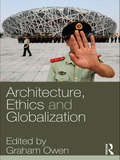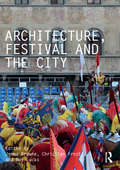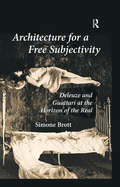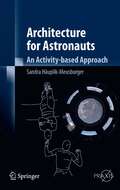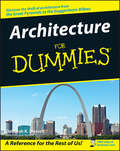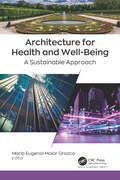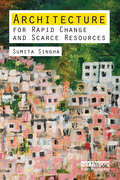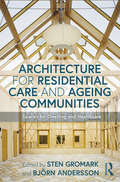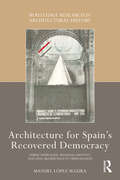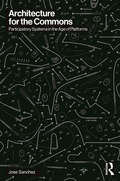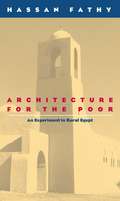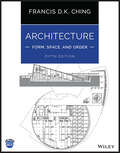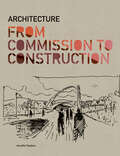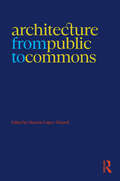- Table View
- List View
Architecture, Ethics and Globalization
by Graham OwenBridging the gap between architectural theory and professional practice studies, this book offers critical inquiry into the shifting ground of ethical thought in the changing climate of the global economy. Looking at issues of contemporary significance to architectural critics, practitioners, educators, and students, the book also examines the role of the architectural academy in providing an education in ethical judgement. Including transcripts of responses and discussions among its contributors, a broad interdisciplinary set of perspectives are debated and often controversial points of view are put forward.
Architecture, Festival and the City
by Jemma Browne Christian Frost Ray LucasHistorically the urban festival served as an occasion for affirming shared convictions and identities in the life of the city. Whether religious or civic in nature, these events provided tangible expressions of social, cultural, political, and religious cohesion, often reaffirming a particular shared ethos within diverse urban landscapes. Architecture has long served as a key aspect of this process exhibiting continuity in the flux of these representations through the parading of elaborate ceremonial floats, the construction of temporary buildings, the ‘dressing’ of existing urban space, the alternative occupations of the everyday, and the construction of new buildings and spaces which then become a part of the background fabric of the city. This book examines how festivals can be used as a lens to examine the relationship between city and citizen and questions whether this is fixed through time, or has been transformed as a response to changes in the modern urban condition. Architecture, Festival and the City looks at the multilayered nature of a diverse selection of festivals and the way they incorporate both orderly (authoritative) and disorderly (subversive) components. The aim is to reveal how the civic nature of urban space is utilised through festival to represent ideas of belonging and identity. Recent political and social gatherings also raise questions about the relationship of these events to ‘ritual’ and whether traditional practices can serve as meaningful references in the twenty-first century.
Architecture, Festival and the City
by Jemma Browne Christian Frost Ray LucasHistorically the urban festival served as an occasion for affirming shared convictions and identities in the life of the city. Whether religious or civic in nature, these events provided tangible expressions of social, cultural, political, and religious cohesion, often reaffirming a particular shared ethos within diverse urban landscapes. Architecture has long served as a key aspect of this process exhibiting continuity in the flux of these representations through the parading of elaborate ceremonial floats, the construction of temporary buildings, the ‘dressing’ of existing urban space, the alternative occupations of the everyday, and the construction of new buildings and spaces which then become a part of the background fabric of the city. This book examines how festivals can be used as a lens to examine the relationship between city and citizen and questions whether this is fixed through time, or has been transformed as a response to changes in the modern urban condition. Architecture, Festival and the City looks at the multilayered nature of a diverse selection of festivals and the way they incorporate both orderly (authoritative) and disorderly (subversive) components. The aim is to reveal how the civic nature of urban space is utilised through festival to represent ideas of belonging and identity. Recent political and social gatherings also raise questions about the relationship of these events to ‘ritual’ and whether traditional practices can serve as meaningful references in the twenty-first century.
Architecture for a Free Subjectivity: Deleuze and Guattari at the Horizon of the Real
by Simone BrottArchitecture for a Free Subjectivity reformulates the French philosopher Gilles Deleuze's model of subjectivity for architecture, by surveying the prolific effects of architectural encounter, and the spaces that figure in them. For Deleuze and his Lacanian collaborator Félix Guattari, subjectivity does not refer to a person, but to the potential for and event of matter becoming subject, and the myriad ways for this to take place. By extension, this book theorizes architecture as a self-actuating or creative agency for the liberation of purely "impersonal effects." Imagine a chemical reaction, a riot in the banlieues, indeed a walk through a city. Simone Brott declares that the architectural object does not merely take part in the production of subjectivity, but that it constitutes its own. This book is to date the only attempt to develop Deleuze's philosophy of subjectivity in singularly architectural terms. Through a screening of modern and postmodern, American and European works, this provocative volume draws the reader into a close encounter with architectural interiors, film scenes, and other arrangements, while interrogating the discourses of subjectivity surrounding them, and the evacuation of the subject in the contemporary discussion. The impersonal effects of architecture radically changes the methodology, just as it reimagines architectural subjectivity for the twenty-first century.
Architecture for a Free Subjectivity: Deleuze and Guattari at the Horizon of the Real
by Simone BrottArchitecture for a Free Subjectivity reformulates the French philosopher Gilles Deleuze's model of subjectivity for architecture, by surveying the prolific effects of architectural encounter, and the spaces that figure in them. For Deleuze and his Lacanian collaborator Félix Guattari, subjectivity does not refer to a person, but to the potential for and event of matter becoming subject, and the myriad ways for this to take place. By extension, this book theorizes architecture as a self-actuating or creative agency for the liberation of purely "impersonal effects." Imagine a chemical reaction, a riot in the banlieues, indeed a walk through a city. Simone Brott declares that the architectural object does not merely take part in the production of subjectivity, but that it constitutes its own. This book is to date the only attempt to develop Deleuze's philosophy of subjectivity in singularly architectural terms. Through a screening of modern and postmodern, American and European works, this provocative volume draws the reader into a close encounter with architectural interiors, film scenes, and other arrangements, while interrogating the discourses of subjectivity surrounding them, and the evacuation of the subject in the contemporary discussion. The impersonal effects of architecture radically changes the methodology, just as it reimagines architectural subjectivity for the twenty-first century.
Architecture for Astronauts: An Activity-based Approach (Springer Praxis Books)
by Sandra Häuplik-MeusburgerLiving and working in extra-terrestrial habitats means being potentially vulnerable to very harsh environmental, social, and psychological conditions. With the stringent technical specifications for launch vehicles and transport into space, a very tight framework for the creation of habitable space is set. These constraints result in a very demanding “partnership” between the habitat and the inhabitant. This book is the result of researching the interface between people, space and objects in an extra-terrestrial environment. The evaluation of extra-terrestrial habitats in comparison to the user’s perspective leads to a new framework, comparing these buildings from the viewpoint of human activity. It can be used as reference or as conceptual framework for the purpose of evaluation. It also summarizes relevant human-related design directions. The work is addressed to architects and designers as well as engineers.
Architecture For Dummies (For Dummies Ser.)
by Deborah K. Dietsch* Just the essential information for readers on the go who want to understand architecture. * Covers the highlights of architectural history, from the Great Pyramids to Frank Gehry's Guggenheim museum in Bilbao. * Explains how to look at a building and appreciate it. Explains when a building's a building and when it's art. * Part of Tens includes: Ten Great Architectural Masterpieces, Ten Biggest Architectural and Engineering Failures, Ten of the Most Interesting Architects Working Today-and more.
Architecture for Health and Well-Being: A Sustainable Approach
by María Eugenia Molar OrozcoThis book explores the importance of architecture designed for the well-being of users. The creation of healthy architecture involves aspects of design, materials, environmental parameters, and intended use of both outdoor and indoor spaces to facilitate a healthy environment. The book provides a unique perspective on architecture that promotes the welfare and security of those using the space, which has proved especially important during the recent COVID-19 pandemic wherein many people were confined indoors. Each chapter in the volume explains from a different angle a topic that takes into consideration how to provide benefit to human beings to achieve a better quality of life within constructions. The first part of the volume provides an overview of the role of architecture to achieve well-being. The book goes on to discuss how to adapt spaces to address urban thermal environments. The book also looks at the use of alternative materials with disinfectant characteristics, which is an important consideration during pandemics and for general health every day. The issue of affordable housing with resilient designs is also addressed as are how the use of good logistics produces healthy spaces. Key features: Describes design conditions that enhance quality of life Considers architectural design for maximizing comfort conditions in different types of climate Reviews the characteristics of materials that contribute to healthy construction Provides attractive ideas on how to create spaces in an organic way Architecture for Health and Well-Being: A Sustainable Approach helps to provide answers to the question of how can we design, plan, and sustain built environments that will foster health and healing. It provides basic information with the aim to generate change in attitudes in those who architectural designers, architectural researchers, city planners, and others.
Architecture for Health and Well-Being: A Sustainable Approach
by María Eugenia Molar OrozcoThis book explores the importance of architecture designed for the well-being of users. The creation of healthy architecture involves aspects of design, materials, environmental parameters, and intended use of both outdoor and indoor spaces to facilitate a healthy environment. The book provides a unique perspective on architecture that promotes the welfare and security of those using the space, which has proved especially important during the recent COVID-19 pandemic wherein many people were confined indoors. Each chapter in the volume explains from a different angle a topic that takes into consideration how to provide benefit to human beings to achieve a better quality of life within constructions. The first part of the volume provides an overview of the role of architecture to achieve well-being. The book goes on to discuss how to adapt spaces to address urban thermal environments. The book also looks at the use of alternative materials with disinfectant characteristics, which is an important consideration during pandemics and for general health every day. The issue of affordable housing with resilient designs is also addressed as are how the use of good logistics produces healthy spaces. Key features: Describes design conditions that enhance quality of life Considers architectural design for maximizing comfort conditions in different types of climate Reviews the characteristics of materials that contribute to healthy construction Provides attractive ideas on how to create spaces in an organic way Architecture for Health and Well-Being: A Sustainable Approach helps to provide answers to the question of how can we design, plan, and sustain built environments that will foster health and healing. It provides basic information with the aim to generate change in attitudes in those who architectural designers, architectural researchers, city planners, and others.
Architecture for Rapid Change and Scarce Resources
by Sumita SinhaArchitects, development practitioners and designers are working in a global environment and issues such as environmental and cultural sustainability matter more than ever. Past interactions and interventions between developed and developing countries have often been unequal and inappropriate. We now need to embrace fresh design practices based on respect for diversity and equality, participation and empowerment. This book explores what it means for development activists to practise architecture on a global scale, and provides a blueprint for developing architectural practices based on reciprocal working methods. The content is based on real situations - through extended field research and contacts with architecture schools and architects, as well as participating NGOs. It demonstrates that the ability to produce appropriate and sustainable design is increasingly relevant, whether in the field of disaster relief, longer-term development or wider urban contexts, both in rich countries and poor countries.
Architecture for Rapid Change and Scarce Resources
by Sumita SinhaArchitects, development practitioners and designers are working in a global environment and issues such as environmental and cultural sustainability matter more than ever. Past interactions and interventions between developed and developing countries have often been unequal and inappropriate. We now need to embrace fresh design practices based on respect for diversity and equality, participation and empowerment. This book explores what it means for development activists to practise architecture on a global scale, and provides a blueprint for developing architectural practices based on reciprocal working methods. The content is based on real situations - through extended field research and contacts with architecture schools and architects, as well as participating NGOs. It demonstrates that the ability to produce appropriate and sustainable design is increasingly relevant, whether in the field of disaster relief, longer-term development or wider urban contexts, both in rich countries and poor countries.
Architecture for Residential Care and Ageing Communities: Spaces for Dwelling and Healthcare
by Sten Gromark Bjö AnderssonArchitecture for Residential Care and Ageing Communities confronts urgent architectural design challenges within residential innovation, ageing communities and healthcare environments. The increasing and diversified demands on the housing market today call for alterability and adaptability in long term solutions for new integrated ways of residing. Meanwhile, an accentuated ageing society requires new residential ways of living, combining dignity, independence and appropriate care. Concurrently, profound changes in technical conditions for home healthcare require rethinking healing environments. This edited collection explores the dynamics between these integrated architectural and caring developments and intends to envision reconfigured environmental design patterns that can significantly enhance new forms of welfare and ultimately, an improved quality of life. This book identifies, presents, and articulates new qualities in designs, in caring processes, and healing atmospheres, thereby providing operational knowledge developed in close collaboration with academics, actors and stakeholders in architecture, design, and healthcare. This is an ideal read for those interested in health promotive situations of dwelling, ageing and caring.
Architecture for Residential Care and Ageing Communities: Spaces for Dwelling and Healthcare
by Sten Gromark; Björn AnderssonArchitecture for Residential Care and Ageing Communities confronts urgent architectural design challenges within residential innovation, ageing communities and healthcare environments. The increasing and diversified demands on the housing market today call for alterability and adaptability in long term solutions for new integrated ways of residing. Meanwhile, an accentuated ageing society requires new residential ways of living, combining dignity, independence and appropriate care. Concurrently, profound changes in technical conditions for home healthcare require rethinking healing environments. This edited collection explores the dynamics between these integrated architectural and caring developments and intends to envision reconfigured environmental design patterns that can significantly enhance new forms of welfare and ultimately, an improved quality of life. This book identifies, presents, and articulates new qualities in designs, in caring processes, and healing atmospheres, thereby providing operational knowledge developed in close collaboration with academics, actors and stakeholders in architecture, design, and healthcare. This is an ideal read for those interested in health promotive situations of dwelling, ageing and caring.
Architecture for Spain's Recovered Democracy: Public Patronage, Regional Identity, and Civic Significance in 1980s Valencia (Routledge Research in Architectural History)
by Manuel López SeguraHistorical studies on the involvement of architecture in twentieth-century politics have overlooked its contribution to building Spain’s democracy. This pioneering book seeks to fill that void. Between the late 1970s and early 1990s, Spain founded representative institutions, launched its welfare state, and devolved autonomy to its regions. The study brings forth the architectural incarnation of that threefold program as it deployed in the Valencian Country, a Catalan-speaking region on Spain’s Mediterranean shores. There, social democratic authorities mobilized architects, planners, and graphic artists to devise a newly open public sphere and to recover a local identity that Franco’s dictatorship had repressed for decades. The research follows the impetus of reform and its contradictions through urban projects, designs for cultural amenities, and the renovation of governmental and professional bodies. Architecture for Spain’s Recovered Democracy contributes to current debates on nationalism and the arts, the environments of democratic socialism, and postmodernism and neoliberalism. As a result, it widens our understanding of how peripheral regions may yield egalitarian architectures of resistance. This book is written for students and researchers in architecture and planning, art history, spatial politics, and Hispanic studies, as well as for a general readership interested in inclusive politics in the built environment.
Architecture for Spain's Recovered Democracy: Public Patronage, Regional Identity, and Civic Significance in 1980s Valencia (Routledge Research in Architectural History)
by Manuel López SeguraHistorical studies on the involvement of architecture in twentieth-century politics have overlooked its contribution to building Spain’s democracy. This pioneering book seeks to fill that void. Between the late 1970s and early 1990s, Spain founded representative institutions, launched its welfare state, and devolved autonomy to its regions. The study brings forth the architectural incarnation of that threefold program as it deployed in the Valencian Country, a Catalan-speaking region on Spain’s Mediterranean shores. There, social democratic authorities mobilized architects, planners, and graphic artists to devise a newly open public sphere and to recover a local identity that Franco’s dictatorship had repressed for decades. The research follows the impetus of reform and its contradictions through urban projects, designs for cultural amenities, and the renovation of governmental and professional bodies. Architecture for Spain’s Recovered Democracy contributes to current debates on nationalism and the arts, the environments of democratic socialism, and postmodernism and neoliberalism. As a result, it widens our understanding of how peripheral regions may yield egalitarian architectures of resistance. This book is written for students and researchers in architecture and planning, art history, spatial politics, and Hispanic studies, as well as for a general readership interested in inclusive politics in the built environment.
Architecture for the Commons: Participatory Systems in the Age of Platforms
by Jose SanchezArchitecture for the Commons dives into an analysis of how the tectonics of a building is fundamentally linked to the economic organizations that allow them to exist. By tracing the origins and promises of current technological practices in design, the book provides an alternative path, one that reconsiders the means of achieving complexity through combinatorial strategies. This move requires reconsidering serial production with crowdsourcing and user content in mind. The ideas presented will be explored through the design research developed within Plethora Project, a design practice that explores the use of video game interfaces as a mechanism for participation and user design. The research work presented throughout the book seeks to align with a larger project that is currently taking place in many different fields: The Construction of the Commons. By developing both the ideological and physical infrastructure, the project of the Commons has become an antidote to current economic practices that perpetuate inequality. The mechanisms of the production and governance of the Commons are discussed, inviting the reader to get involved and participate in the discussion. The current political and economic landscape calls for a reformulation of our current economic practices and alternative value systems that challenge the current market monopolies. This book will be of great interest not only to architects and designers studying the impact of digital technologies in the field of design but also to researchers studying novel techniques for social participation and cooperating of communities through digital networks. The book connects principles of architecture, economics and social sciences to provide alternatives to the current production trends.
Architecture for the Commons: Participatory Systems in the Age of Platforms
by Jose SanchezArchitecture for the Commons dives into an analysis of how the tectonics of a building is fundamentally linked to the economic organizations that allow them to exist. By tracing the origins and promises of current technological practices in design, the book provides an alternative path, one that reconsiders the means of achieving complexity through combinatorial strategies. This move requires reconsidering serial production with crowdsourcing and user content in mind. The ideas presented will be explored through the design research developed within Plethora Project, a design practice that explores the use of video game interfaces as a mechanism for participation and user design. The research work presented throughout the book seeks to align with a larger project that is currently taking place in many different fields: The Construction of the Commons. By developing both the ideological and physical infrastructure, the project of the Commons has become an antidote to current economic practices that perpetuate inequality. The mechanisms of the production and governance of the Commons are discussed, inviting the reader to get involved and participate in the discussion. The current political and economic landscape calls for a reformulation of our current economic practices and alternative value systems that challenge the current market monopolies. This book will be of great interest not only to architects and designers studying the impact of digital technologies in the field of design but also to researchers studying novel techniques for social participation and cooperating of communities through digital networks. The book connects principles of architecture, economics and social sciences to provide alternatives to the current production trends.
Architecture for the Poor: An Experiment in Rural Egypt
by Hassan FathyArchitecture for the Poor describes Hassan Fathy's plan for building the village of New Gourna, near Luxor, Egypt, without the use of more modern and expensive materials such as steel and concrete. Using mud bricks, the native technique that Fathy learned in Nubia, and such traditional Egyptian architectural designs as enclosed courtyards and vaulted roofing, Fathy worked with the villagers to tailor his designs to their needs. He taught them how to work with the bricks, supervised the erection of the buildings, and encouraged the revival of such ancient crafts as claustra (lattice designs in the mudwork) to adorn the buildings.
Architecture for the Poor: An Experiment in Rural Egypt
by Hassan FathyArchitecture for the Poor describes Hassan Fathy's plan for building the village of New Gourna, near Luxor, Egypt, without the use of more modern and expensive materials such as steel and concrete. Using mud bricks, the native technique that Fathy learned in Nubia, and such traditional Egyptian architectural designs as enclosed courtyards and vaulted roofing, Fathy worked with the villagers to tailor his designs to their needs. He taught them how to work with the bricks, supervised the erection of the buildings, and encouraged the revival of such ancient crafts as claustra (lattice designs in the mudwork) to adorn the buildings.
Architecture: Form, Space, and Order
by Francis D. ChingARCHITECTURE THE GOLD STANDARD IN INTRODUCTORY ARCHITECTURE TEXTS, FULLY UPDATED TO REFLECT THE LATEST DEVELOPMENTS IN THE FIELD For more than forty years, the beautifully illustrated Architecture: Form, Space, and Order has served as the classic introduction to the basic vocabulary of architectural design. In this fifth edition, more recent additions to the architectural panoply illustrate how contemporary digital and building technologies have influenced the development of architectural forms and spaces and how architectural siting and design have responded to the call for more environmentally responsible buildings. It is designed to encourage critical thought and to promote a more evocative understanding of architecture. The fifth edition is updated with many new urban design and building precedents from a diverse range of cultural and geographic areas New content focuses on the latest technology and trends in structure, construction, materials, and sustainability Includes more than 800 illustrations, many hand-drawn, which demonstrate the foundations and concepts every architect must master Architecture: Form, Space, and Order distills complex concepts of design into a clear focus and brings difficult abstractions to life. It explains form and space in relation to light, view, openings, and enclosures and explores the organization of space, and the elements and relationships of circulation, as well as proportion and scale. In addition, the text’s detailed illustrations demonstrate the concepts presented and reveal the relationships between fundamental elements of architecture through the ages and across cultures.
Architecture: Form, Space, and Order
by Francis D. ChingARCHITECTURE THE GOLD STANDARD IN INTRODUCTORY ARCHITECTURE TEXTS, FULLY UPDATED TO REFLECT THE LATEST DEVELOPMENTS IN THE FIELD For more than forty years, the beautifully illustrated Architecture: Form, Space, and Order has served as the classic introduction to the basic vocabulary of architectural design. In this fifth edition, more recent additions to the architectural panoply illustrate how contemporary digital and building technologies have influenced the development of architectural forms and spaces and how architectural siting and design have responded to the call for more environmentally responsible buildings. It is designed to encourage critical thought and to promote a more evocative understanding of architecture. The fifth edition is updated with many new urban design and building precedents from a diverse range of cultural and geographic areas New content focuses on the latest technology and trends in structure, construction, materials, and sustainability Includes more than 800 illustrations, many hand-drawn, which demonstrate the foundations and concepts every architect must master Architecture: Form, Space, and Order distills complex concepts of design into a clear focus and brings difficult abstractions to life. It explains form and space in relation to light, view, openings, and enclosures and explores the organization of space, and the elements and relationships of circulation, as well as proportion and scale. In addition, the text’s detailed illustrations demonstrate the concepts presented and reveal the relationships between fundamental elements of architecture through the ages and across cultures.
Architecture from Commission to Construction: From Commission To Construction
by Jennifer HudsonThis book provides an in-depth study of the design and construction processes behind 25 leading contemporary buildings. Covering a broad range of international projects, the book illustrates the working methods and creative concerns of both long-established and emerging international architects. Every stage of each project is included, from the demands of the original brief, through early sketches and design development to investigation of building regulations and collaboration with engineers, contractors, builders and clients. Each project is presented through an explanatory overview, sketches, details, CAD renderings, models and construction shots, all captioned in great technical detail. Architecture from Commission to Construction offers both students and professional architects an inspiring and informative overview of how today's major architectural projects are designed and built.
Architecture from Public to Commons
by Marcelo López-DinardiThis book provides an urgent framework and collective reflection on understanding ways to reconsider and recast architecture within ideas and politics of the commons and practices of commoning. Architecture from Public to Commons opens with Institutions the dialogue with the scales of the commons, the limits of language for fluid identities, the practices and challenges of architecture as an institution, the design of objects with apparent shared value in Chile, land protocols that explore alternatives to profit-seeking of property in New York, and spirited conversations about revolting against architectural labor from Latin America. Continuing chapters explore, under Territories, the boundaries of Blackness across the Atlantic between Ethiopia and Atlanta, the underground woven network with conflicting grounds of ipê wood between Brazil and the US, water cycles in depleted territories in Chile, indigenous women-led territorial and human rights struggles in Guatemala, climate change accidental commons in California, and the active search for racial justice between design and place in New Orleans. Contributions range from theoretical and historical essays to current case studies of on-the-ground practices in the US, the Middle East, Europe, and Central and South America. Bringing together architects, scholars, artists, historians, sociologists, curators, and activists, this book instils an urgent framework and renewed set of tools to pivot from architecture’s traditional public to a politicized commons. It will greatly interest students, academics, and researchers in architecture, urban design, architectural theory, landscape architecture, political economy, and sociology.
Architecture from Public to Commons
This book provides an urgent framework and collective reflection on understanding ways to reconsider and recast architecture within ideas and politics of the commons and practices of commoning. Architecture from Public to Commons opens with Institutions the dialogue with the scales of the commons, the limits of language for fluid identities, the practices and challenges of architecture as an institution, the design of objects with apparent shared value in Chile, land protocols that explore alternatives to profit-seeking of property in New York, and spirited conversations about revolting against architectural labor from Latin America. Continuing chapters explore, under Territories, the boundaries of Blackness across the Atlantic between Ethiopia and Atlanta, the underground woven network with conflicting grounds of ipê wood between Brazil and the US, water cycles in depleted territories in Chile, indigenous women-led territorial and human rights struggles in Guatemala, climate change accidental commons in California, and the active search for racial justice between design and place in New Orleans. Contributions range from theoretical and historical essays to current case studies of on-the-ground practices in the US, the Middle East, Europe, and Central and South America. Bringing together architects, scholars, artists, historians, sociologists, curators, and activists, this book instils an urgent framework and renewed set of tools to pivot from architecture’s traditional public to a politicized commons. It will greatly interest students, academics, and researchers in architecture, urban design, architectural theory, landscape architecture, political economy, and sociology.
Architecture, Futurability and the Untimely: On the Unpredictability of the Past (Architekturen #66)
by Ingrid Mayrhofer-HufnaglThe planetary instantaneity that digital technologies have enabled is leading to an effacement of the divisions that separate the past from the future, ensuring that the present is ubiquitous. While contemporary architecture seems to have lost the capacity to conceive of the past as a transformative force, this book stresses the need to rethink today's complex temporal mechanisms through the notion of the untimely. This concept opens up a whole spectrum of possibilities to go beyond what seems predictable. The contributors to this book employ critical concepts and architectural design tools in order to offer experimental and speculative approaches for unknown futures of architecture.
